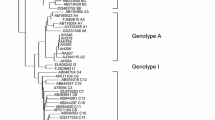Abstract
The use of rituximab has been associated with increased risk of hepatitis B virus (HBV) reactivation in patients who are hepatitis B surface antigen (HBsAg) negative and antihepatitis B core antibody (anti-HBc) positive. We aim to determine the rate of HBV reactivation in this group of patients who received rituximab-containing combination chemotherapy without concomitant antiviral prophylaxis and to identify potential risk factors for reactivation. Sixty-two HBsAg negative/anti-HBc positive patients with B-cell lymphoma treated with rituximab-based immunochemotherapy from 2006 to 2009 were included. None of the patients received concomitant antiviral prophylaxis. In this cohort, 48 (77%) patients received rituximab with cyclophosphamide, doxorubicin, vincristine, and prednisone (R-CHOP), eight (13%) received rituximab with cyclophosphamide, vincristine and prednisolone, and six (10%) received other chemotherapy regimens. Two patients suffered HBV reactivation; both were above 70 years of age, received R-CHOP chemotherapy and were negative for antihepatitis B surface antibody (anti-HBs) at baseline. One of the two patients reactivated shortly after completion of R-CHOP chemotherapy while the other reactivated during rituximab maintenance treatment. Thus, the overall reactivation rate in this cohort of patients is 3% (2/62), 4% (2/48), and 25% (1/4) in patients who received R-CHOP chemotherapy and who received rituximab maintenance, respectively. The rate of HBV reactivation is low in patients who are HBsAg negative/anti-HBc positive receiving rituximab-based combination chemotherapy without concomitant antiviral prophylaxis. However, elderly patients, particularly those without anti-HBs, seemed particularly at risk.
Similar content being viewed by others
References
Koo YX, Tan DS, Tan IB, Tao M, Chow WC, Lim ST (2010) Hepatitis B virus reactivation and role of antiviral prophylaxis in lymphoma patients with past hepatitis B virus infection who are receiving chemoimmunotherapy. Cancer 116(1):115–121. doi:10.1002/cncr.24742
Feugier P, Van Hoof A, Sebban C, Solal-Celigny P, Bouabdallah R, Fermé C, Christian B, Lepage E, Tilly H, Morschhauser F, Gaulard P, Salles G, Bosly A, Gisselbrecht C, Reyes F, Coiffier B (2005) Long-term results of the R-CHOP study in the treatment of elderly patients with diffuse large B-cell lymphoma: a study by the Groupe d’Etude des Lymphomes de l’Adulte. J Clin Oncol 23(18):4117–4126. doi:10.1200/JCO.2005.09.131
Dall’Era M, Wofsy D (2010) Biologic therapy for systemic lupus erythematosus. Discov Med 9(44):20–23
Ramos-Casals M, Soto MJ, Cuadrado MJ, Khamashta MA (2009) Rituximab in systemic lupus erythematosus: a systematic review of off-label use in 188 cases. Lupus 18(9):767–776. doi:10.1177/0961203309106174
Hui CK, Cheung WW, Zhang HY, Au WY, Yueng YH, Leung AY, Leung N, Luk JM, Lie AK, Kwong YL, Liang R, Lau GK (2006) Kinetics and risk of de novo hepatitis B infection in HBsAg-negative patients undergoing cytotoxic chemotherapy. Gastroenterology 131(1):59–68. doi:10.1053/j.gastro.2006.04.015
Fukushima N, Mizuta T, Tanaka M, Yokoo M, Ide M, Hisatomi T, Kuwahara N, Tomimasu R, Tsuneyoshi N, Funai N, Sueoka E (2009) Retrospective and prospective studies of hepatitis B virus reactivation in malignant lymphoma with occult HBV carrier. Ann Oncol 20(12):2013–2017
Yeo W, Chan TC, Leung NW, Lam WY, Mo FK, Chu MT, Chan HL, Hui EP, Lei KI, Mok TS, Chan PK (2009) Hepatitis B virus reactivation in lymphoma patients with prior resolved hepatitis B undergoing anticancer therapy with or without rituximab. J Clin Oncol 27(4):605–611. doi:10.1200/JCO.2008.18.0182
Niitsu N, Hagiwara Y, Tanae K, Kohri M, Takahashi N (2010) Prospective analysis of hepatitis B virus reactivation in patients with diffuse large B-cell lymphoma after rituximab combination chemotherapy. J Clin Oncol. doi:10.1200/JCO.2010.29.7531
Ji D, Cao J, Hong X, Li J, Wang J, Chen F, Wang C, Zou S (2010) Low incidence of hepatitis B virus reactivation during chemotherapy among diffuse large B-cell lymphoma patients who are HBsAg-negative/HBcAb-positive: a multicenter retrospective study. Eur J Haematol 85(3):243–250. doi:10.1111/j.1600-0609.2010.01474.x
Matsue K, Kimura S, Takanashi Y, Iwama K, Fujiwara H, Yamakura M, Takeuchi M (2010) Reactivation of hepatitis B virus after rituximab-containing treatment in patients with CD20-positive B-cell lymphoma. Cancer. doi:10.1002/cncr.25253
Pei SN, Chen CH, Lee CM, Wang MC, Ma MC, Hu TH, Kuo CY (2010) Reactivation of hepatitis B virus following rituximab-based regimens: a serious complication in both HBsAg-positive and HBsAg-negative patients. Ann Hematol 89(3):255–262. doi:10.1007/s00277-009-0806-7
Loomba R, Rowley A, Wesley R, Liang TJ, Hoofnagle JH, Pucino F, Csako G (2008) Systematic review: the effect of preventive lamivudine on hepatitis B reactivation during chemotherapy. Ann Intern Med 148(7):519–528
Lalazar G, Rund D, Shouval D (2007) Screening, prevention and treatment of viral hepatitis B reactivation in patients with haematological malignancies. Br J Haematol 136(5):699–712. doi:10.1111/j.1365-2141.2006.06465.x
Liang R (2009) How I treat and monitor viral hepatitis B infection in patients receiving intensive immunosuppressive therapies or undergoing hematopoietic stem cell transplantation. Blood 113(14):3147–3153. doi:10.1182/blood-2008-10-163493
Delaney WE 4th, Borroto-Esoda K (2008) Therapy of chronic hepatitis B: trends and developments. Curr Opin Pharmacol 8(5):532–540
Firpi RJ, Nelson DR (2008) Management of viral hepatitis in hematologic malignancies. Blood Rev 22(3):117–126
Cheng PN, Chang TT (2008) Entecavir: a potent antiviral with minimal long-term resistance in nucleoside-naive chronic hepatitis B patients. Expert Rev Anti Infect Ther 6(5):569–579
Conflict of interest and source of funding
There are no financial disclosures from any authors. The authors report no conflicts of interests.
Condensed Abstract
The risk of HBV reactivation is low in patients who are HBsAg negative/anti-HBc positive receiving rituximab-based combination chemotherapy without concomitant antiviral prophylaxis. Close surveillance instead of routine antiviral prophylaxis is a viable option for this group of patients.
Author information
Authors and Affiliations
Corresponding author
Rights and permissions
About this article
Cite this article
Koo, Y.X., Tay, M., Teh, Y.E. et al. Risk of hepatitis B virus (HBV) reactivation in hepatitis B surface antigen negative/hepatitis B core antibody positive patients receiving rituximab-containing combination chemotherapy without routine antiviral prophylaxis. Ann Hematol 90, 1219–1223 (2011). https://doi.org/10.1007/s00277-011-1241-0
Received:
Accepted:
Published:
Issue Date:
DOI: https://doi.org/10.1007/s00277-011-1241-0




